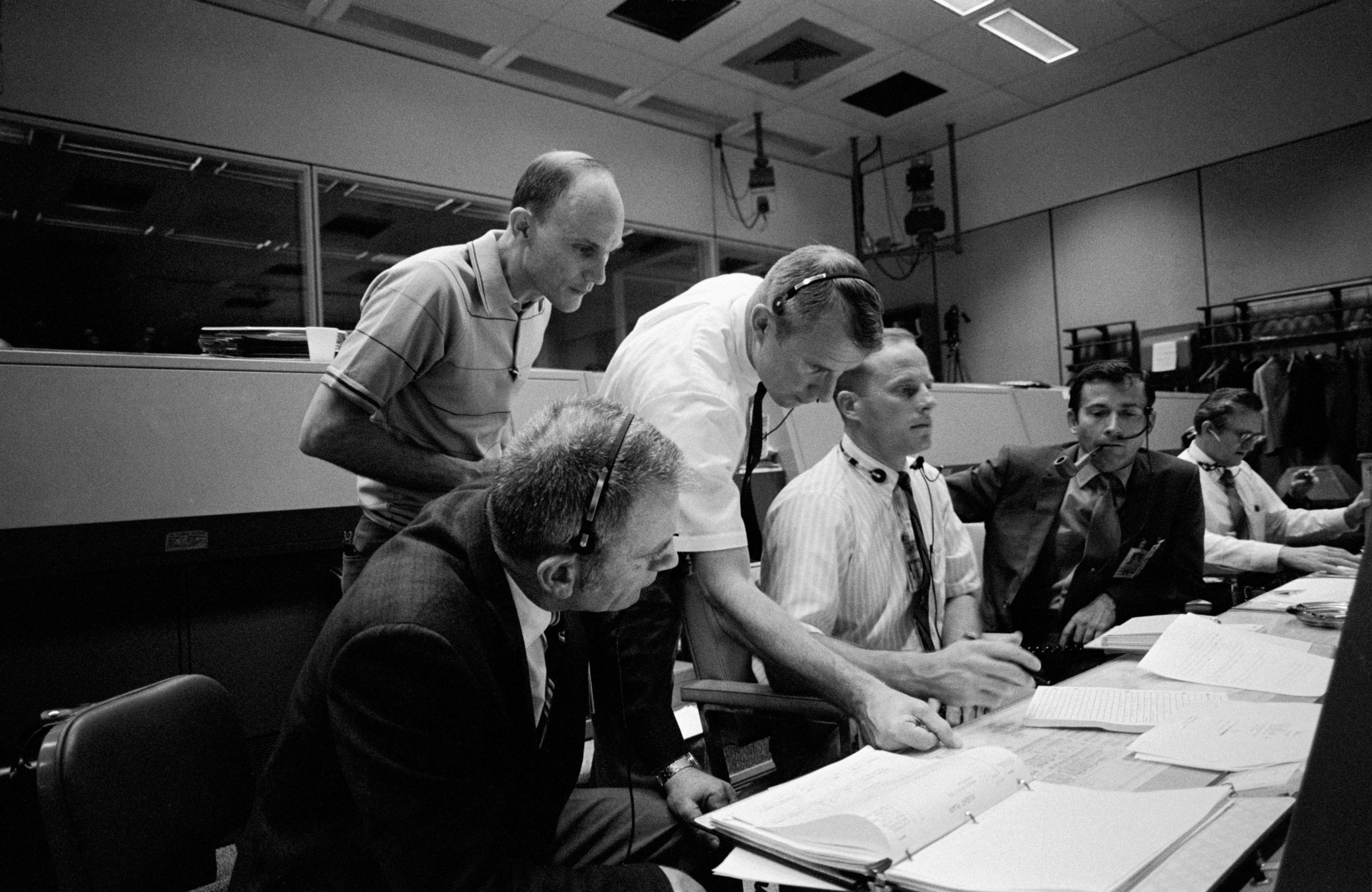
Forty-five years ago, this week, the lives of three humans literally hung in the balance, more than 200,000 miles (320,000 km) from Earth. For weeks, the superstitious naysayers had labeled Apollo 13 as “unlucky,” but until now all had gone well. Flight controllers had joked that they were “bored to tears,” because the spacecraft was behaving so well. Then, with horrifying abruptness, a calamity engulfed Apollo 13 which not only threatened its chances of landing on the Moon, but placed Commander Jim Lovell, Command Module Pilot (CMP) Jack Swigert, and Lunar Module Pilot (LMP) Fred Haise in dire peril. As detailed in yesterday’s AmericaSpace history article, one of two oxygen tanks in the ship’s service module had exploded, puncturing the other, and had blown out an entire side panel. Now, as life-sustaining oxygen poured into space, controllability was lost, communications were sporadic, and the crew and Mission Control realized they had only minutes in which to make a decision.
The man in charge of the electrical, environmental, and communications systems, known as the “EECOM,” was Seymour “Sy” Liebergot. He knew that the situation was dire. Two of the command module Odyssey’s fuel cells were dead, and the third was in the process of dying; but if the reactant valves to the dead cells could be closed, it might allow them to isolate the problem and save whatever was left in the final cell. “Shutting off the valves either would stop the bleeding,” wrote Jim Lovell in his autobiography, Lost Moon, “allowing Odyssey to stabilize itself and power back up, or it would do nothing at all, allowing the controllers to give up on the ship altogether.” However, shutting down the valves was a desperate, last-ditch endeavor—for they could not be restarted in flight, and it would be an acknowledgement that Apollo 13 was now an aborted mission.
White Team Flight Director Gene Kranz agreed with Liebergot. He was well aware that the prospect of a lunar landing was now gone, and the intricate, 10-day flight plan had morphed into a totally new mission: that of getting the three men home alive. Still, when fellow astronaut Jack Lousma, seated at the Capcom’s console at the Manned Spacecraft Center (MSC) in Houston, Texas, radioed the news, it was met with crushing disappointment by the crew.
“We want you to close the react valve on fuel cell 3. You copy?”
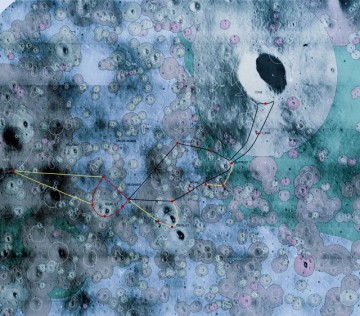
Humanity’s third lunar landing mission was over, before it had even begun, and the ultimate prize for Lovell and Haise—becoming the fifth and sixth men to set foot on the Moon—would instead go to another pair of space travelers.
At this point, the obvious course of action might have been to use the service module’s Service Propulsion System (SPS) engine to swing the ship in a great U-turn and bring the astronauts back to Earth—a so-called “Direct Abort.” Certainly, Milt Windler, flight director of the Maroon Team, initially favored this option but was vetoed by Kranz and by the Black Team flight director, Glynn Lunney. They argued that there was still no clear understanding of what had caused the explosion and how badly damaged the service module really was. If the SPS had been crippled, a direct abort might be dangerous. The presence of the lunar module Aquarius might buy them some time and keep another option open. Seated at Kranz’ console, Chris Kraft—then-Deputy Director of MSC, who had been called at home and pulled out of the shower by his wife to rush into Mission Control—agreed that a direct abort would close off too many options. It was too risky.
Other controllers felt the same way. There was some inexplicable sense of dread which warned them to not even attempt to use the SPS. Regardless, the explosion meant that Apollo 13 now lacked sufficient electricity to open valves to the engine’s combustion chamber, swivel its nozzle, and steer a five-minute burn, so the decision quickly became a moot one. The only available option was to continue their journey to the Moon, loop around it, and somehow re-establish themselves on the free-return trajectory … and this meant Lovell, Swigert, and Haise would be forced to exist for long enough to make it back home. Central to the plan was Aquarius itself. The astronauts knew it and Mission Control knew it.
“We’re starting to think about the LM lifeboat,” radioed Capcom Jack Lousma.
“That’s what we’ve been thinking about, too,” replied Swigert. By this time, Lovell and Haise had already made their way through the tunnel to the lunar module, in the hope that they could condense a two-hour systems activation checklist into around 30 minutes. Aquarius’ descent engine did have enough impetus to place them back onto a free-return trajectory, but only Odyssey could survive the furnace heat of re-entry into Earth’s atmosphere and bring the three men home. Quickly, Swigert began shutting down a fifth of the command module’s systems, to conserve what little power was left. At length, all systems would be shut down, including the critical guidance platform and the computer. When they neared Earth, the astronauts would evacuate Aquarius and move into Odyssey, whose systems would have to be reactivated after a three-day deep freeze. The command module’s batteries—offering only 10 hours of life—would then be relied upon for control during re-entry, to deploy the parachutes and to ensure a survivable splashdown.
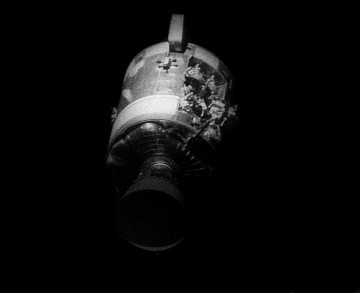
But before Swigert could shut down Odyssey, the guidance and control of Apollo 13 had to be shifted over to Aquarius’ computer, and that was no easy task. The craft was still surrounded by debris from the explosion—maybe 7.5 miles (12 km) wide, or more—and this glinted in the fierce sunlight, making it virtually impossible to gain reliable star “fixes” for navigation. Lovell and Haise were therefore obliged to copy, by hand, all of the navigational and alignment data from Odyssey’s computer, calculate the different frames of reference between the two craft, and input them into Aquarius’ computer. Moreover, they had to do all of this with great haste, for the command module was minutes away from death.
Lovell must have remembered emergency training scenarios on the ground, in which he had been obliged to do manual navigation, and he had made mistakes. Now, in space, Haise urged him to take his time. It was late in the evening and Lovell was exhausted; he asked Lousma to double-check his arithmetic before inputting it into the computer.
At length, he yelled up the tunnel to Swigert to shut down the rest of Odyssey’s systems. At 12:51 a.m. CDT on 14 April 1970, just over four hours since the explosion, the command module fell silent as a crypt. As Jack Swigert left his craft and entered Aquarius, he must have hoped with every fibre of his being that Apollo 13 would not become their crypt in the days to follow. Looking into his crewmates’ eyes, he had only five words for them: “It’s up to you now.”
Lovell and Haise were two of the most competent experts in lunar module systems, but steering the entire spacecraft from Aquarius was awkward and bore some similarities to steering a wheelbarrow down the street with a long-handled broom. Two hours after shutting down Odyssey, at 2:43 p.m. CDT, Lovell fired the descent engine for precisely 30.7 seconds, thus re-establishing Apollo 13 on a free-return trajectory and committing them to a splashdown somewhere in the Indian Ocean.
“How do you like this sim?” quipped Lousma.
“It’s a beauty,” Lovell shot back. No simulation on Earth had ever been this dire.
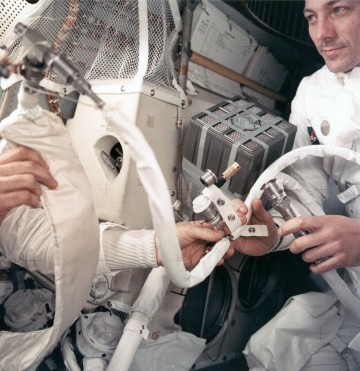
Splashing down in the Indian Ocean was problematic, because it was far from any of the U.S. Navy’s recovery ships and it would require four full days to get back to Earth. This was significantly longer than Aquarius’ systems could sustain the three men. Could the SPS engine be burned as they swung around the Moon? This might bring them into the Atlantic, off the Brazilian coastline, in 38 hours … but the plan fell victim, again, to the unknown damage to the service module’s engine. Could the service module itself be jettisoned and Aquarius made to perform a “long” burn of its descent engine, thereby shaving off more time? That could bring Odyssey into the South Atlantic in 40 hours. Many controllers, though, wanted the service module to stay put; it covered Odyssey’s heat shield and there were real fears that solar ultraviolet radiation and temperature variations in cislunar space could impair its ability to protect them during re-entry. It too was rejected. In any case, the 30.7-second burn had been so good that Lovell and Haise would probably not need to make any further firings; they were back on the free-return trajectory, which would guide them back to Earth. Whether or not they would still be alive by the time that Odyssey hit the ocean was another issue.
Their predicament had by now reached the media. At first, reports were issued by the television networks, informing audiences that there had been an accident aboard Apollo 13, but that the crew “were in no immediate danger.” The true severity of what had occurred came in Chris Kraft’s comment to a journalist during the night. When asked for his assessment of the situation, Kraft responded: “I would say that this is about as serious a situation as we’ve ever had in manned spaceflight.” Even after burning Aquarius’ engine and setting themselves back onto the free-return trajectory, the chances were slim. Years later, Lovell remarked that, if someone had given him Apollo 13’s list of problems before launch and asked for his judgement on chances, “I’d have said they were virtually nil.”
Perversely, the explosion could not really have happened at a better time. If the stir of the service module’s cryogenic tanks and the resultant blast had occurred earlier in the mission, there would have been insufficient stores of electrical power and water to even sustain them for the swing around the Moon … and if it had occurred later, after Lovell and Haise’s landing, there would have been no descent engine to press into service at all. “We could probably have gotten up and rendezvoused with the command module,” Lovell said, “but we wouldn’t have had any fuel to go home.”
Four main issues required resolution: oxygen, carbon dioxide, electricity, and water. Oxygen was aplenty, particularly since two Moonwalks had been planned, both of which would have involved totally venting the cabin and repressurizing it from tanks in the descent stage. Lovell and Haise’s space suit backpacks also had their own reserves. Haise calculated that Aquarius’ oxygen stores could keep them alive for eight to 10 days.
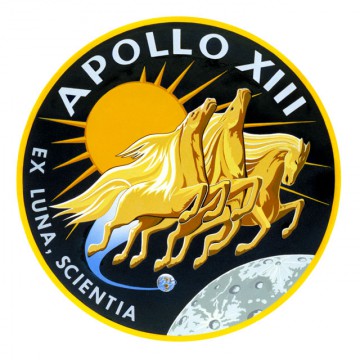
Carbon dioxide from the astronauts’ exhaled breath, though, was more difficult to overcome. Normally, it was removed by a canister of lithium hydroxide, which “scrubbed” it from the air to ensure that it did not accumulate to toxic levels. Unchecked, it would kill the crew: firstly by giving them severe headaches, then racing hearts, drowsiness, and finally death. The lander was designed to accommodate a crew for a maximum of 45 hours, and had five lithium hydroxide canisters … but the journey back to Earth would take 90 hours. More canisters were needed, but the two vehicles had been designed by different companies (North American Rockwell and Grumman) and the lithium hydroxide canisters in the command module were square, whereas those of the lander had been designed to fit a round hole: They simply could not be plugged into Aquarius’ environmental controls.
After a day and a half aboard the lunar module, a warning light illuminated to advise that the carbon dioxide was climbing toward toxic levels. Ed Smylie, the head of NASA’s Crew Systems Division, developed a means of overcoming this hurdle. In a day and a half, his team had conceived a routine to build something which resembled a mailbox from materials that Lovell, Swigert, and Haise had aboard: sections of duct tape, socks, the ripped-off cover of a flight plan, the oxygen hose from a space suit, and a few plastic bags.
In Ron Howard’s 1995 movie, Apollo 13, Smylie and his team were portrayed dumping an assortment of bric-a-brac onto a table and clumsily sorting through it, during a coffee-fueled, round-the-clock effort to cobble something together to save the astronauts. The reality was quite different, and better organized. “If you saw the movie, it wasn’t like that,” Smylie said later. “Everything is pretty calm, cool and collected in our business.” It was also surprisingly elegant: Encased and taped within plastic bags, the box boasted little fashioned “archways” at the top to keep it from being sucked against the inlet screens. This improvisation was critical in keeping the crew alive long enough to return to Earth, and Fred Haise would later praise its creators with words to this effect. After the instructions had been radioed up, the astronauts dug out the bits and pieces and spent about an hour building a pair of boxes. Within six hours of fitting the first one into place, the carbon dioxide level in the lunar module began to fall and, at length, became unmeasurable. The astronauts photographed their work for posterity, and when they returned to Earth they found that their boxes were remarkably similar to what was intended.
The next issue was electricity, since Aquarius had no fuel cells and ran exclusively on batteries. It was capable of a 33-hour stay on the Moon and two surface EVAs. To keep it operational for more than two days meant turning off its cabin lights, its gauges, and even its computer. During quiet times, Haise thumbed through his procedures book to add up the requirements for individual components and determined that they could operate on 18-20 amps at minimum power, switching virtually everything off, apart from the air circulation fan and glycol coolant system to keep themselves and the lander alive and, of course, the radio to talk to Houston. That should be enough, he figured, to see them through to the time when they would have to re-enter the command module for the return to Earth.
Cooling water for the lander’s systems, finally, was the resource in real short supply; Haise anticipated that it would run out five or six hours before re-entry. However, when Neil Armstrong and Buzz Aldrin jettisoned the ascent stage of their lander, Eagle, in July 1969, for an engineering test, they deliberately left all of its systems running and turned off its water supply … and it continued transmitting valuable data for no less than eight hours, until it finally overheated. Haise was certain that Aquarius could do at least as well. His certainty was shared by many experts in Mission Control, and by the fifth day of the mission, it seemed likely that—barring any further problems—they would probably make it.
The final part of this four-part article will appear tomorrow.
Want to keep up-to-date with all things space? Be sure to “Like” AmericaSpace on Facebook and follow us on Twitter: @AmericaSpace




One Comment
One Ping
Pingback:‘We Show You on the Mains': 45 Years Since the Unlucky Voyage of Apollo 13 (Part 4) « AmericaSpace